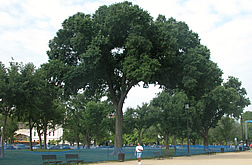This page has been archived and is being provided for reference purposes only. The page is no longer being updated, and therefore, links on the page may be invalid.
Read the magazine story to find out more. |
|
Jefferson Trees Resistant to Dutch Elm Disease
By Alfredo FloresJune 13, 2006
A large-scale program to screen American elm trees for resistance to Dutch elm disease may lead to trees that can ward off this deadly disease, according to Agricultural Research Service (ARS) scientists and cooperators.
The fungus that causes Dutch elm disease (DED)--Ophiostoma ulmi—has wiped out around 77 million American elms, decimating these graceful trees along streets and in parks and gardens, since its introduction to the United States in 1931.
To combat this exotic and deadly disease that originated in France, researchers screened thousands of American elm trees for resistance. Thanks to the efforts of ARS scientists with the U.S. National Arboretum in Washington, D.C., and collaborators, enough old specimens were located and kept alive to provide the germplasm necessary to develop DED-tolerant trees.
The arboretum's tree-breeding project was led by ARS geneticist Denny Townsend until his 2005 retirement. Townsend worked with horticulturalist Susan Bentz at the ARS Floral and Nursery Plants Research Unit (FNPRU) in Glenn Dale, Md.
In 2005, the newest American elm—named Jefferson—was released jointly by ARS and the National Park Service (NPS), after collaborative screening tests by Townsend and James L. Sherald, NPS Natural Resource Officer, showed it to have an outstanding level of DED tolerance. It was cloned in 1993 from the original tree, a survivor of about 300 elms planted on the National Mall in Southwest Washington in the 1930s.
Jefferson grows in the typical vase shape up to nearly 70 feet tall, has broad U-shaped branch unions, and has leaves that turn dark-green earlier in the spring—and stay dark later in the fall—than most other elms. FNPRU research leader John Hammond regards Jefferson as a good "street tree" because it can withstand pollution from city traffic and has wide adaptability, growing in USDA hardiness zones 5 through 7.
While this durable, DED-tolerant elm may once again fill parks and grace famous landmarks with true American elms, Jefferson won’t be available to consumers for about four years. But specimens can be seen on the National Mall, next to the old Smithsonian building, and will soon be at the arboretum. Efforts also are under way to propagate quantities for nursery cooperators.
Read more about the research in the June 2006 issue of Agricultural Research magazine.
ARS is the U.S. Department of Agriculture's chief scientific research agency.

